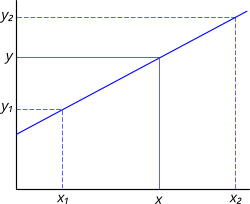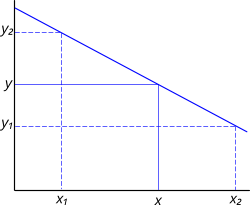Algebra Formulas
The following table contains alternative ways of expressing algebraic functions.
General
a-x = 1 / ax |
|
a1/x = x√a |
|
a-1/x = 1 / x√a |
|
(a.b)x = ax . bx |
|
(ax)y = ax.y |
|
aˣ⁺ʸ = aˣ . aʸ |
e.g.: a2.5 = a² . a0.5 |
xⁿ/yⁿ + 1 = (xⁿ + yⁿ) / yⁿ |
|
(x - a) / A = x/A - a/A |
|
(x² - a²) = (x - a).(x + a) |
|
Simplify: (x + b)/(x² - a²) (x + b)/(x² - a²) = (x + b) / [(x - a).(x + a)] Continue in order to prove the above: |
|
Factorial: e.g. 5! = 5x4x3x2x1 |
|
Binomial
|
(a+b)n = an + nC1.a(n-1).b + nC2.a(n-2).b2 + ..... + nCr.a(n-r).br + ..... bn |
If; 0 = ax² + bx + c |
Simple and Compound Interest
The following table contains formulas for calculating simple and compound interest.
Where: P = the principal sum, p = percentage interest, n = payment term (years), q = payments per year, I = interest paid over full term, m = amount of each payment & Pn = total amount paid over 'n' years
Simple
I = P.p.n |
Pn = I + P |
Compound
I = Pn - P |
Pn = P.(1 + p/q)n.q |
m = Pn / n.q |
Net-Present-Value
V = Pn / (1+p/q)n.q |
Discount(simple) = Pn(simple) - V |
Discount(compound) = Pn(compound) - V |
Progressions
The following table contains the formulas for arithmetic and geometric progressions.
Note: r = 2nd term ÷ 1st term, d = 2nd term - 1st term, n = number of terms
Arithmetic
nth term = 1st term + d.(n-1) |
Σn terms = n.[2 . 1st term.(n-1)] / 2 |
Geometric
nth term = 1st term . r(n-1)) |
Σn terms = 1st term . (1 - rn) / (1 - r) [r < 1] |
Σn terms = 1st term . (rn - 1) / (r - 1) [r > 1] |
Logarithms
The following table contains alternative ways of expressing logarithmic functions.
Note: 'base' refers to the logarithmic base, which can be any positive number
The most common bases are 10 and 2.71828182845905 (the base for natural logs, normally written thus 'ln(x)')
e = 1 + 1/1 + 1/2 + 1/3 + 1/4 + 1/5 + 1/6 + 1/7 + ..... = 2.71828182845905 |
ex = 1 + x¹/1 + x²/2 + x³/3 + x⁴/4 + x⁵/5 + x⁶/6 + x⁷/7 + .... |
e-x = 1 - x¹/1 + x²/2 - x³/3 + x⁴/4 - x⁵/5 + x⁶/6 - x⁷/7 + .... |
y = Logbase(basey) |
Log x = Logbase(x) |
logbase(x) = loga(x) / loga(base) |
base(a+b+c) = base(a).base(b).base(c) |
Logbase(x) - Logbase(y) = log10(base).x/y |
Logbase(xa) = a.Logbase(x) |
Logbase(x) - Logbase(y) = z |
1/exp(x) = exp(-x) |
eln(x) = x |
Xn = Y |
Simultaneous Equations
I'll begin by giving you the answer for a 3ʳᵈ-order series, and then show you how to reach it by calculation.
If we set x=1.5, y=-0.5 & z=0.3
the following third-order set of simultaneous equations will generate these results:
(a) 6x - 4y + 3z = 11.9
(b) 2x - 2y + 9z = 6.7
(c) 5x + 8y - 2z = 2.9
factor1 = 3/9 = 0.33333333 [(a)z ÷ (b)z]
multiply each value in (b) by factor1 to create (d):
(d) 0.666666667x - 0.666666667y + 3z = 2.233333333
subtract (a) from (d):
(e) -5.333333333x + 3.333333333y + 0z = -9.666666667
factor2 = 2/5 = 0.4 [(b)x ÷ (c)x]
multiply each value in (c) by factor2 to create (f):
(f) 2x + 3.2y - 0.8z = 1.16
subtract (b) from (f):
(g) 0x + 5.2y - 9.8z = -5.54
factor3 = -4/8 = -0.5 [(a)y ÷ (c)y]
multiply each value in (c) by factor3 to create (h):
(h) -2.5x - 4y + 1z = -1.45
subtract (a) from (h):
(i) -8.5x + 0y - 2z = -13.35
factor4 = -9.8/-2 = -0.5 [(i)z ÷ (g)z]
multiply each value in (i) by factor4 to create (j):
(j) -41.65x + 0y - 9.8z = -65.415
subtract (g) from (j):
(k) -41.65x - 5.2y + 0z = -59.875
factor5 = -5.333333333/-41.65 = 0.12805122 [(k)x ÷ (e)x]
multiply each value in (k) by factor5 to create (l):
(l) -5.333333333x - 0.665866347y + 0z = -7.667066827
subtract (e) from (l):
(m) 0x - 3.99919968y + 0z = 1.99959984
y = 1.99959984 / -3.99919968 = -0.5 [from (m)]
x = (-9.666666667 - 3.333333333*-0.5) / -5.33333333 = 1.5 [from (e)]
z = (-5.54 - 5.2*-0.5) / -9.8 = 0.3 [from (g)]
The above is deliberately long-winded to accentuate the things you can do to obtain the correct result. You may well find a shorter procedure, but it should follow the same rules.
A 2ⁿᵈ-order sequence will be faster, and a 4ᵗʰ-order sequence (and greater) will take much longer, but they can all be resolved using exactly the same procedure; result by elimination.
Determinants
Determinants are a means of solving simultaneous equations, e.g.
a₁.x + b₁.y + c₁.z = 0
a₂.x + b₂.y + c₂.z = 0
a₃.x + b₃.y + c₃.z = 0
which can be written thus:
|a₁,b₁,c₁|
|a₂,b₂,c₂|
|a₃,b₃,c₃|
The following table contains the procedure for solving determinants.
|
2ᴺᴰ Order a₁.w + b₁.x = 0 |a₁,b₁| = a₁.b₂ - a₂.b₁ To solve a 2ᴺᴰ Order equation you perform the calculation as shown above |
|
3ᴿᴰ Order a₁.w + b₁.x + c₁.y = 0 |a₁,b₁,c₁| = a₁.|b₂.c₂| - a₂.|b₁.c₁| + a₃.|b₁.c₁| To solve a 3ᴿᴰ Order equation you convert to 2ᴺᴰ Order equations as shown above then solve 2ᴺᴰ Order equations |
|
4ᵀᴴ Order a₁.w + b₁.x + c₁.y + d₁.z = 0 |a₁,b₁,c₁.d₁| = a₁.|b₂.c₂.d₂| - a₂.|b₁.c₁.d₁| + a₃.|b₁.c₁.d₁| - a₄.|b₁.c₁.d₁| To solve a 4ᵀᴴ Order equation you convert to 3ᴿᴰ Order equations as shown above, then convert to 2ᴺᴰ Order equations then solve 2ᴺᴰ Order equations |
The same procedure may be followed for all subsequent Order equations: 5ᵀᴴ, 6ᵀᴴ, 7ᵀᴴ, etc.

Fig 1. Finding x and y
Slope
A calculation method to find a point on a graph of positive or negative slope
Positive Slope
with reference to Fig 1
x = (x₂-x₁).(y-y₁)/(y₂-y₁) + x₁
y = (y₂-y₁).(x-x₁)/(x₂-x₁) + y₁
Negative Slope

Fig 2. Finding x and y
with reference to Fig 2
x = (x₂-x₁).(y-y₂)/(y₁-y₂) + x₁
y = (y₁-y₂).(x-x₁)/(x₂-x₁) + y₂
Geometry
Properties of a Sphere
Circumference: C = 2.π.r
Surface Area: A = 4.π.r²
Volume: V = ⁴/₃.π.r³
Distance between 'n' equally spaced points on the surface:
Arc: d = π.A / C.n = 6.π.V / A.n
Linear: ℓ = 2.r.Sin(½.d/r)
to find 'n':
n = π/Asin(½.ℓ/r)
If ℓ = r then:
n = π/Asin(½) = 6
In this special case; 'n = 6' is a constant, irrespective of the spherical radius
Further Reading
You will find further reading on this subject in reference publications(19)